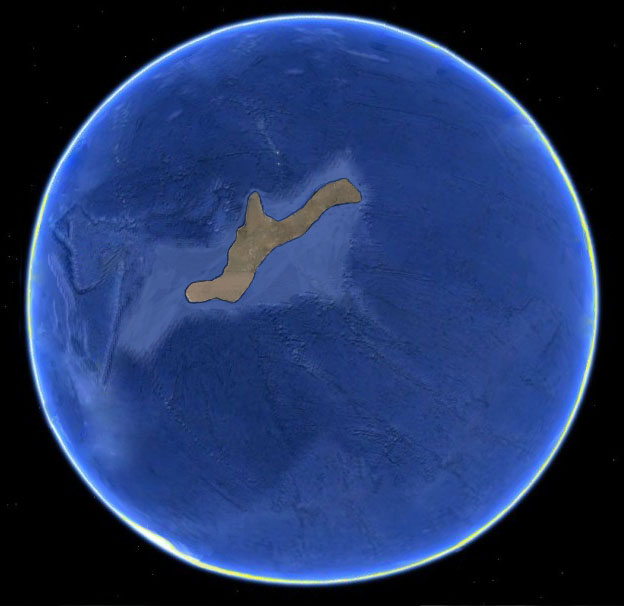The seven supercontinents
Sydney Hollingsworth. 03/19/2021

You’ve probably heard of Pangaea, the enormous supercontinent that formed 300 million years ago and broke apart into the continents we know today. But did you know scientists believe that a total of seven supercontinents have formed over the course of Earth’s history?
Supercontinents are single connected continents made up of all or most of the land on the surface of Earth. Plate tectonics under these landmasses float on the molten mantle under the Earth’s crust, slowly pushing continents together and breaking them apart. The plates are moved over long periods of time by changes in temperature, intensity or direction in the flow of the mantle. This results in new supercontinents forming and splitting up about every 400 to 500 million years.
But why do supercontinents matter? Plate tectonics move so slowly, about three to five centimeters a year, that their changes are hardly noticeable to humans. In fact, they are so hard to detect that the theory of continental drift wasn’t proposed until the 20th century, and still wasn’t accepted until the 1960s.
However, we now know that over billions of years, continental drift has shaped almost every aspect of the Earth as we know it. Extinction events and climate changes are closely tied to plate tectonics. For example, the Snowball Earth theory hypothesizes that two ice ages about 720 million years ago were caused by erosion of mountain ranges that pushed nutrients into the sea, resulting in an explosion of oxygen-producing bacteria. This drastic change in Earth’s atmosphere would have had many effects on the climate, and eventually led to the surface of the Earth becoming covered in glaciers, as well as one of the planet’s earliest mass extinctions.
Even after the possibility of supercontinents was accepted, it was nearly impossible to find evidence of the supercontinents before Pangaea. Since subduction (the movement of plates under each other and into the mantle) and seafloor melt replace plate tectonic material, nearly all of the land that makes up the Earth’s crust is less than 200 million years old.
Recently, thanks to research into the mineral distribution and carbon dating, we can piece together what past supercontinents might have looked like, how they formed and how they broke apart. Although all models of early Earth’s plate tectonics are very theoretical, scientists can generally agree that there have been a total of seven supercontinents.
The first and earliest supercontinent to have existed is the most theoretical. The supercontinent Vaalbara is suspected to have formed 3.6 billion years ago from the Kaapvaal and Pilbara cratons (stable blocks of Earth’s crust that form the center of a continent). These cratons can now be found in South Africa and Western Australia.
The supercontinent Ur, its name meaning “original” in German, formed shortly after Vaalbara from the same cratons approximately 3 billion years ago. The specifics of this continent are also very theoretical, and despite its supercontinent status, the land mass would have been smaller than modern-day Australia. Ur remained intact as a part of other supercontinents until Pangaea split apart.
About 300 million years after Ur’s formation, the supercontinent Kenorlan came together from the merging of Vaalbara and the newly formed continental crust along the planet’s equator. At this time, eukaryotic organisms were emerging in the world’s oceans. As the supercontinent split apart, geologic events and the rise of oxygen-producing, single-celled life created the conditions for the Earth’s first glaciers.
The next supercontinent only existed for a short while: Colombia, also called Nuna or Hudsonland, formed about 1.8 billion years ago and broke up 1.5 billion years ago. During this time, the first plants colonized land in the form of red algae.
By the time of the rise of the next supercontinent, Rodinia, 1.1 billion years ago, the Earth’s landmasses began to loosely resemble our current continents. Differently from most other supercontinents, Rodinia formed from two-sided subduction, where both tectonic plates involved are pushed down into the mantle, rather than just one. Unfortunately, this means the supercontinent’s formation did not involve much volcanic activity, leaving less preserved mineral evidence of the event. However, we do know that during Rodinia’s existence, the first multicellular organisms began to appear in oceans around the world.
About 100 million years after Rodinia split in two, the supercontinent, Pannotia came together while most land was located at the Earth’s poles in glacier form. Two oceans, the Panthalassa and Pan-African, formed and later merged into one. Pannotia eventually split apart into four pieces: Gondwana, Baltica, Siberia and Laurentia. Gondwana is sometimes considered its own supercontinent due to its large size, but it was not connected to the three other fairly large continents of the time.
Before the formation of Pangaea, life began to make its way from the ocean onto land. So, when the continents came together, these diverse forms of life which had evolved separately for over 100 million years were introduced to each other and began to spread and adapt to their new environments. The collision of the northern half, Laurasia, and southern half, Gondwana, also created many of the mountain ranges we see on our planet today. The end of Pangaea saw the rise of the dinosaurs. As landmasses drifted apart, species were separated and quickly evolved to adapt to their new, respective continents. By the time they came back together or were reconnected via land bridges, the dinosaurs would be long extinct.
From Pangaea, the landmasses of Eurasia and North America would form from the Northern half, and Africa, South America, India, Australia and Antarctica would form from the Southern half. In the meantime, a continuous ocean ran across the entire equator, producing a very different global landscape than what we have today.
Because of research into past supercontinents and plate tectonics, we can guess what our planet could look like someday in the distant future. Three such theories of how the next supercontinent will come together are the Pangaea Ultima, Amasia and Novopangaea theories.
The Pangaea Ultima theory is the most commonly mentioned. In this scenario, Africa and Australia will continue their northward courses until they smash into Europe and Asia. Over millions of years, the Atlantic Ocean will widen, creating a new underwater mountain range down its center, until the Americas come full circle and collide with the Euro-African continent.
The Amasia supercontinent theory is similar to Pangaea Ultima as it also involves the expansion of the Atlantic, but it instead predicts that the continents will join together as they move to the North Pole. The Novopangaea theory is based on this idea but predicts Australia and Antarctica will join where the Pacific Ocean is today.
The study of past supercontinents and plate tectonics gives us insight into the inner workings of the Earth. Our planet is larger and older than we can comprehend, with more history than we can hope to learn. Understanding how it has changed can shed light on valuable information about almost every aspect of the Earth and the creatures that have lived on it, showing us how far we’ve come and where we might be headed.
